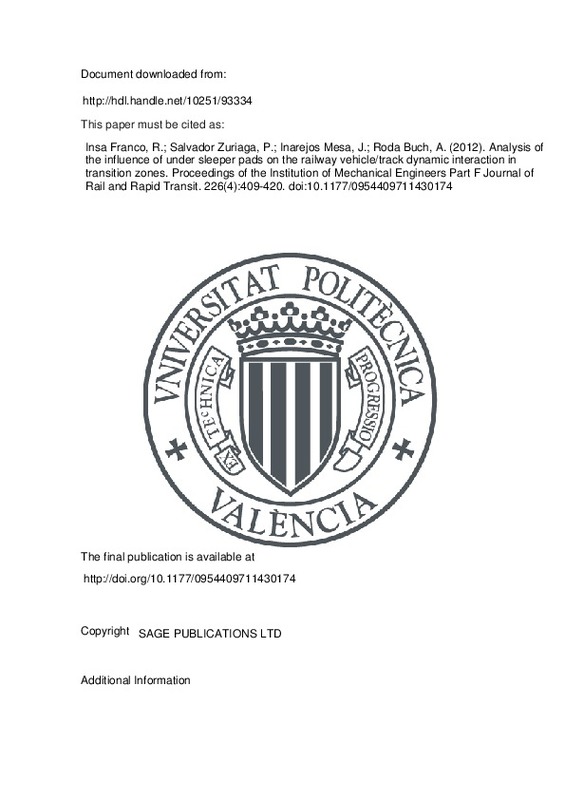JavaScript is disabled for your browser. Some features of this site may not work without it.
Buscar en RiuNet
Listar
Mi cuenta
Estadísticas
Ayuda RiuNet
Admin. UPV
Analysis of the influence of under sleeper pads on the railway vehicle/track dynamic interaction in transition zones
Mostrar el registro sencillo del ítem
Ficheros en el ítem
| dc.contributor.author | Insa Franco, Ricardo
|
es_ES |
| dc.contributor.author | Salvador Zuriaga, Pablo
|
es_ES |
| dc.contributor.author | Inarejos Mesa, Javier
|
es_ES |
| dc.contributor.author | Roda Buch, Alejandro
|
es_ES |
| dc.date.accessioned | 2017-12-22T07:38:39Z | |
| dc.date.available | 2017-12-22T07:38:39Z | |
| dc.date.issued | 2012 | es_ES |
| dc.identifier.issn | 0954-4097 | es_ES |
| dc.identifier.uri | http://hdl.handle.net/10251/93334 | |
| dc.description.abstract | [EN] Sharp changes in the vertical stiffness levels of a track can increase train and infrastructure deterioration to the point where there is a serious risk of a derailment. Major overloading and unloading forces are created between the different track and vehicle components. This phenomenon has grown in importance as the operational speeds of trains have increased with the expansion of high-speed lines. In order to solve this problem a method has to be found to smooth the changes in vertical stiffness levels along the track. In the present paper, the combination of transition regions and under- sleeper pads (USPs) has been studied. The research has been performed by means of a dynamic vehicle-track interaction model created by synthesizing a series of sub-models of individual effects. The analysed variables allow various track configurations, train travelling speeds and the stiffness of the USPs to be investigated. The obtained results show that combining transition zones with USPs pads allows more homogeneous vertical stiffness levels to be achieved along the tracks which results in improved dynamic behaviour of the vehicle-track system. © IMechE 2011. | es_ES |
| dc.description.sponsorship | This work was supported by Ineco-Tifsa. | en_EN |
| dc.language | Inglés | es_ES |
| dc.publisher | SAGE PUBLICATIONS LTD | es_ES |
| dc.relation.ispartof | Proceedings of the Institution of Mechanical Engineers Part F Journal of Rail and Rapid Transit | es_ES |
| dc.rights | Reserva de todos los derechos | es_ES |
| dc.subject | Stiffness change | es_ES |
| dc.subject | Train-track interaction | es_ES |
| dc.subject | Transition zones | es_ES |
| dc.subject | Under sleeper pads | es_ES |
| dc.subject.classification | INGENIERIA MECANICA | es_ES |
| dc.subject.classification | INGENIERIA E INFRAESTRUCTURA DE LOS TRANSPORTES | es_ES |
| dc.title | Analysis of the influence of under sleeper pads on the railway vehicle/track dynamic interaction in transition zones | es_ES |
| dc.type | Artículo | es_ES |
| dc.identifier.doi | 10.1177/0954409711430174 | es_ES |
| dc.rights.accessRights | Abierto | es_ES |
| dc.contributor.affiliation | Universitat Politècnica de València. Departamento de Ingeniería Mecánica y de Materiales - Departament d'Enginyeria Mecànica i de Materials | es_ES |
| dc.contributor.affiliation | Universitat Politècnica de València. Departamento de Ingeniería e Infraestructura de los Transportes - Departament d'Enginyeria i Infraestructura dels Transports | es_ES |
| dc.contributor.affiliation | Universitat Politècnica de València. Escuela Técnica Superior de Ingenieros de Caminos, Canales y Puertos - Escola Tècnica Superior d'Enginyers de Camins, Canals i Ports | es_ES |
| dc.description.bibliographicCitation | Insa Franco, R.; Salvador Zuriaga, P.; Inarejos Mesa, J.; Roda Buch, A. (2012). Analysis of the influence of under sleeper pads on the railway vehicle/track dynamic interaction in transition zones. Proceedings of the Institution of Mechanical Engineers Part F Journal of Rail and Rapid Transit. 226(4):409-420. doi:10.1177/0954409711430174 | es_ES |
| dc.description.accrualMethod | S | es_ES |
| dc.relation.publisherversion | http://doi.org/10.1177/0954409711430174 | es_ES |
| dc.description.upvformatpinicio | 409 | es_ES |
| dc.description.upvformatpfin | 420 | es_ES |
| dc.type.version | info:eu-repo/semantics/publishedVersion | es_ES |
| dc.description.volume | 226 | es_ES |
| dc.description.issue | 4 | es_ES |
| dc.relation.pasarela | S\236437 | es_ES |
| dc.contributor.funder | Ineco-Tifsa |







![[Cerrado]](/themes/UPV/images/candado.png)

